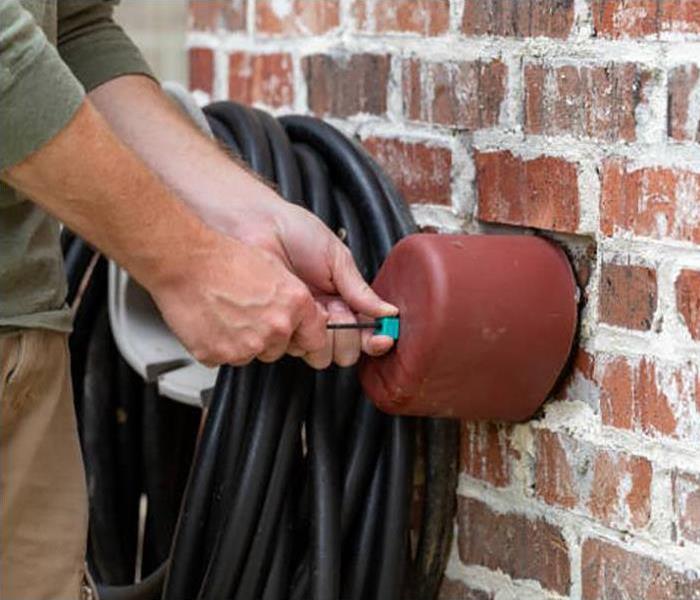Winterizing Your Home Like A Pro
11/27/2023 (Permalink)
 Protect the pipes! Frozen pipes can burst during the winter and cause major problems for homeowners.
Protect the pipes! Frozen pipes can burst during the winter and cause major problems for homeowners.
Now is the time to get your home and business ready for the cold season. Winterization is an important process that homeowners should not neglect for their property.
The purpose of winterizing a home is to avoid higher energy costs and any damage caused by cold weather and snow. Here’s how to winterize your home properly so that it can weather the season:
- Clean the Gutters
Gutters are the workhorses of your home’s exterior. They direct rainwater and snow away from your roof to prevent water from seeping in and causing damage. But gutters can’t do this very important job when they’re clogged with dead leaves and other debris. Whether you hire someone to do it for you or climb a ladder yourself, make sure your gutters are clear before the first snowfall.
TIP: A telescoping gutter wand makes it easier and faster to clean your gutters.
- Inspect the Roof and Attic
Now’s the time to make any repairs to your roof so that it won’t leak in the rain or the snow. If you have an attic, replace or add insulation to keep drafts out.
TIP: Be sure to wear gloves whenever you are handling fiberglass insulation.
- Check the Chimney
If you have a fireplace, you’ll want to make sure the chimney is clear of any buildup. A dirty chimney can be a fire hazard, so hire a chimney sweep to ensure it’s clear and you can build fires safely all season.
TIP: If you don’t actively use your fireplace, inflate a chimney balloon and plug up the space to keep out the cold.
- Weatherproof Windows and Doors
Cold air can creep in through windows and doors, so be sure to replace any weatherstripping around them. Apply caulking to seal any gaps around windows—you can also do this for any cracks in the siding, too. Unless you have newer, energy-efficient windows, you can apply window film to keep out the cold. A door sweep installed on the bottom of your door can keep drafts out, too.
TIP: To find the source of a draft, hold a lit candle a couple of inches away from a window or door. If the flame is extinguished, apply caulking or weatherstripping to that spot.
- Protect the Pipes
Frozen pipes can burst during the winter and cause major problems for homeowners. Here are some things you can do to avoid this wintertime nightmare:
-Cover the exterior faucet with an insulated slip-on cover. This will prevent any remaining water from freezing. Exterior pipes should be wrapped with insulation tubing, which can be found at your local hardware store. Do not wrap your pipes with bath towels or newspaper! These coverings hold moisture like a wet rag and defeat the purpose of covering your pipes in the first place.
-Know the location of your main water shutoff so that you can access it quickly in an emergency.
TIP: If you’re going to be away from your home during the winter, be sure to keep your thermostat set to about 55 degrees Fahrenheit. A programmable thermostat makes it easy to keep your house at the right temperature so that your pipes won’t freeze.
- Service the HVAC system
Replace your furnace filter and schedule a service appointment so that your heating system is ready to go before you need it. This might mean scheduling a service call when you’ve got your AC pumping during the summer because service appointments can be hard to get during the height of the season.
TIP: If you live in a climate where there are four distinct seasons, have your HVAC serviced twice a year so that it runs well in both the cold weather and hot weather.
- Prepare Your Patio and Deck
This is particularly important if you live in a region where snow is likely. Cover patio furniture with weatherproof covers or, if possible, store it away in a garage or shed. If your deck is wooden, a fresh coat of sealant will protect it in wet weather.
TIP: Some patio furniture can be left out in the cold weather without being damaged. It all depends on the material used in making it. Teak furniture, for example, can stand up to winter, though furniture made from other types of wood cannot. When in doubt, cover or store your outdoor furniture.
- Ensure Snow Removal Tools Are Accessible
It’s one thing to have a gassed-up snowblower ready and waiting in your shed. But it’s another thing when a snowstorm dumps a foot of snow and you can’t get to it. Well before there is even a single flake in the forecast, be sure that all of your snow removal tools, including shovels and de-icing agents like salt and sand, are out of storage and easily accessible when snow starts to fall. This might be a small task on your winterizing list, but it’s an important one.
TIP: Need new shovels or a snow blower? Buy them any time of year except during the winter, when supplies are low and prices are high. Your best chances to catch a sale will be before or after the snowy season, but know that inventory will likely be limited if you wait until after the winter.
Source: forbes.com





 24/7 Emergency Service
24/7 Emergency Service